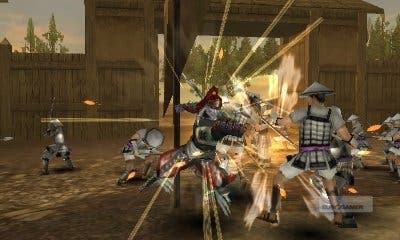Samurai Warriors: Chronicles
Slash fiction.
The camera is also a little problematic. With no right analogue stick, you'll have to periodically squeeze the left shoulder button to see what's directly in front of your hero. It's a workable solution to what is a hardware rather than a software issue, but either way it's hardly ideal in the heat of battle, and is enough to make a difference on Hard level and above. Being attacked by an enemy outside your field of vision is never fun, and the jarring perspective shift as it whip-pans around is enough to make you go boss-eyed – more so if you've left the 3D slider up.
Otherwise, there's little to surprise franchise regulars. As is customary, interstitial conversations allow you to forge a deeper bond with certain characters, improving their performance on the battlefield and eventually affording the opportunity to use their weapon – though if you're anything like me, you'll have poured all your gold into synthesising the most powerful sword for Bob.
(Of course, this then precipitates an hour or so's grind as you replay earlier levels to earn enough money and items to repeat the process for your partners, who will otherwise be left hopelessly inefficient in battle, stuck as they are with feeble Lv.1 weapons.)
It's a structure that exacerbates the game's already repetitive nature, as the later stages on Normal difficulty are all but impossible unless your chosen cohorts are as well-equipped as the protagonist. It's an opportunity to master a number of different fighting styles, though in truth most characters handle fairly similarly; certainly the differences are less pronounced than in Capcom's like-minded Sengoku Basara.

Lacking that game's campy self-awareness, Samurai Warriors is an awfully po-faced affair. Despite the silly moustaches and the outlandish costumes, the dialogue is ponderous and portentous, and with so many different characters and motivations involved, it's difficult to really engage with anyone.
Each battle is preceded by a lengthy, unskippable sequence of story text, as a pair of blue and red Tetrominoes representing opposing forces jiggle about on a weathered parchment map before you can even think about organising and equipping your team and moving out. It's perhaps interesting if you're a Japanese history student, but most will simply want the game to shut up and get on with it.
Even so, you have to concede that Koei knows exactly what it's doing with its flagship series, and while there's a distinct lack of ambition here, equally there's nothing ruinous for long-term fans. If it lacks the impact of its home console cousins, then that's not always the fault of the developer.
Some will want nothing more than a 3D Samurai Warriors game they can play on the move, and for them Chronicles will fit the bill nicely. The rest of us might wish for something that doesn't feel quite so underpowered.
